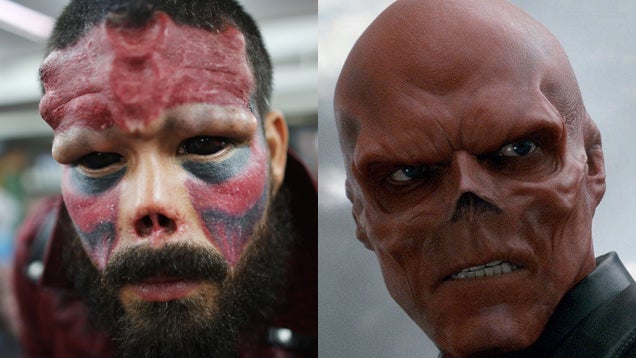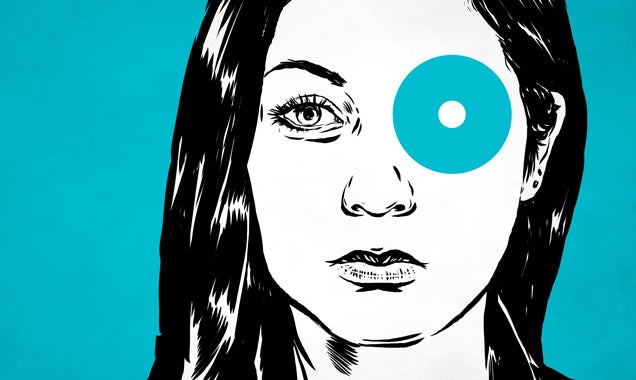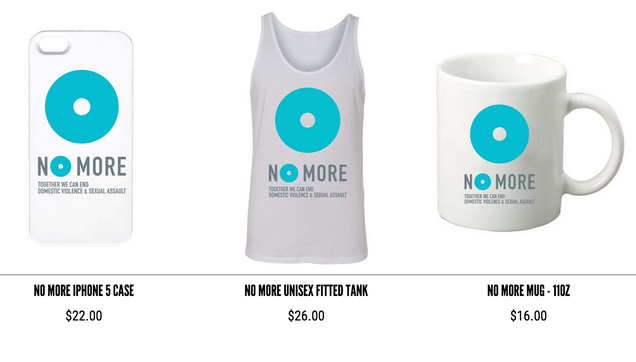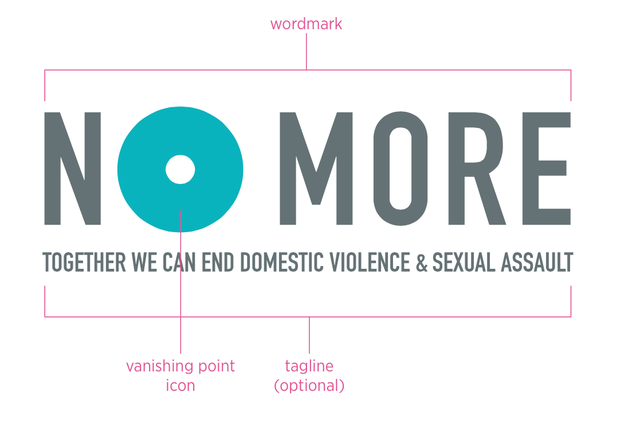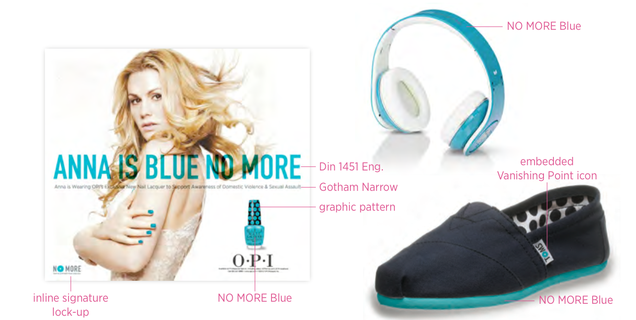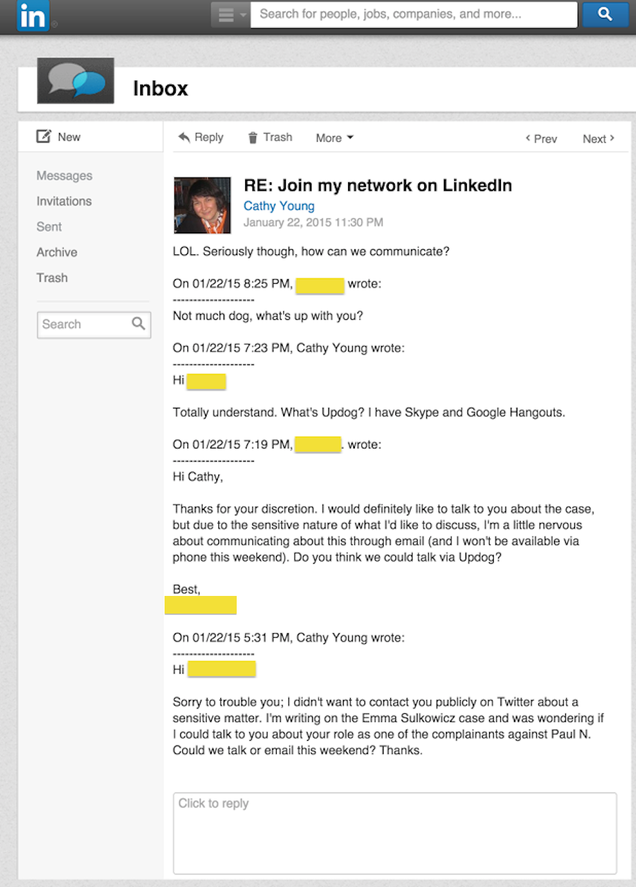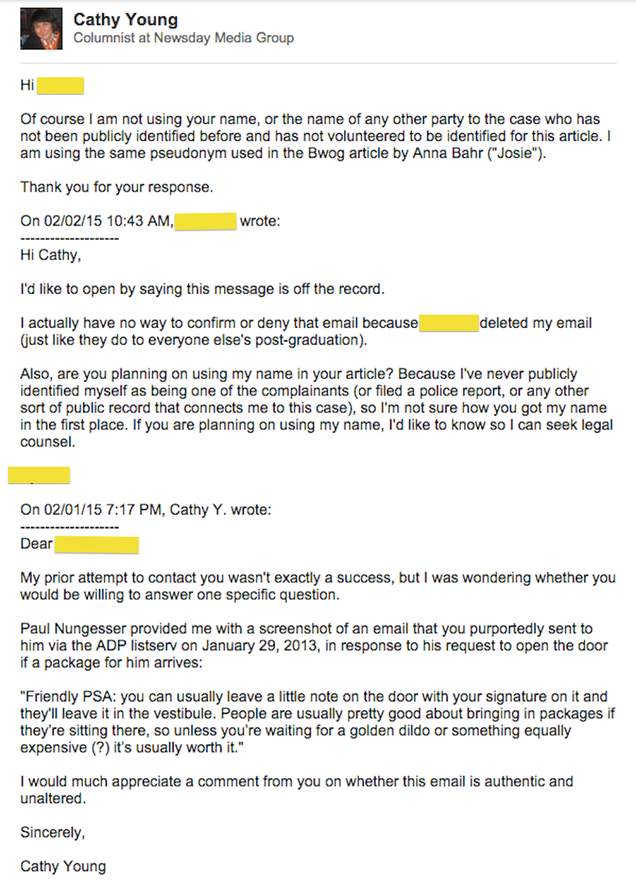![How to Make an Accused Rapist Look Good]()
In the days after
Rolling Stone's University of Virginia rape story blew up in its face, both liberal and conservative finger-waggers agreed that Sabrina Rubin Erdely's journalistic transgression would almost certainly make things more difficult for the "real" victims. They were right.
After months of widespread coverage of sexual assault allegations at Columbia, this week the Daily Beast published a
piece by the reliably rape-skeptical Cathy Young that purported to find the gray area in the accusations. Young focused on Paul Nungesser, the Columbia student reportedly accused of sexual assault by three different women. "Columbia Student: I Didn't Rape Her" was the headline.
"If Nungesser is not a sexual predator," Young concluded, "he could be seen as a true victim: a man who has been treated as guilty even after he has proved his innocence."
To develop this contrary point of view, Young interviewed Nungesser, his family, and the student assigned to be his supporter in the disciplinary process, and she cited messages exchanged between him and his accusers. She was unable to interview any of Nungesser's alleged victims, who worried that the piece would be what it ultimately ended up being: an example of reporting that reads with a veneer of neutrality but nonetheless advances the notion of hysterical, scheming women unfairly turning ambiguous circumstances into an attack on a hapless target.
Jezebel has spoken with three students who accuse Nungesser of sexual assault—one of whom, a male classmate, is currently in the process of pursuing disciplinary action through Columbia and has never previously spoken publicly about his allegations. There is not, by these students' accounts, much ambiguity in their experiences with Nungesser.
In August of 2012, on the first day of her sophomore year at Columbia, Emma Sulkowicz alleges that her friend, a fellow student named Paul Nungesser, held her down on his bed and violently raped her. After her assault, she's said, she decided not to pursue disciplinary action against him for the same reasons many acquaintance rape survivors don't pursue justice against their attackers: it's just too much trouble.
But after Sulkowicz learned about two other women Nungesser had allegedly sexually assaulted, she decided to press forward, bringing charges against him before her college's disciplinary board. Nungesser was found "not responsible." He'd earlier been found "responsible" for another sexual assault, but had appealed and won after the woman grew tired of fighting the proceedings. So he was allowed to remain on campus.
Sulkowicz began carrying her mattress between classes in an act of protest that doubled as her senior thesis in visual art; soon after, one of the most prominent and visible anti-campus-sexual-assault advocates of our time was minted. In the months after going public with her identity, Sulkowicz has appeared on the cover of New York magazine and several major news channels. Her continued anti-rape advocacy has even caught the eye of New York Senator Kirsten Gillibrand, who invited Sulkowicz to be her guest at last month's State of the Union.
Sulkowicz's alleged rapist isn't a fan of her newfound prominence. After he returned from a semester abroad, Nungesser spoke with the
New York Times and commented on Sulkowicz's political visibility. In interviews, he carefully points out that he's a feminist with a feminist mom and says that he didn't do any of the things that three different women have accused him of doing—that he is the real victim.
Cathy Young has a history of—to put it mildly—rape victim skepticism. To put it harshly, she's a writer who has been writing virtually the same rape-is-a-hysterical-feminist-fantasy op-ed over and over again for years. Here Young trots out the MRA standby "men get raped just as much as women!" for a Time piece that dismisses the sexual assault of women too drunk to consent as "alcohol-addled sex" instead of real rape. (You know, the kind when "a rape victim... is either physically overpowered or attacked when genuinely incapacitated.") Here's Cathy Young using Rolling Stone's now-discredited article as a jumping off point to claim, basically, that most rape isn't real. Here's a similar word salad—"Feminist Agitprop and Rape-Hoax Denialism"—published weeks earlier. And that's just the first page of Google results.
In this most recent
Daily Beast piece, Young aims for a more measured tone. Instead of mere assertion, she brings out evidence: communications—supplied by Nungesser—between the accused and his accusers. In Young's reading, these paint doubt onto the credibility of the three women who accused Nungesser of sexual assault.
First, she points to transcripts from Facebook chats between Sulkowicz and Nungesser, both before and after the alleged assault occurred. They appear friendly.
On Aug. 29, two days after the alleged rape, Nungesser messaged Sulkowicz on Facebook to say, "Small shindig in our room tonight—bring cool freshmen." Her response:
lol yusss
Also I feel like we need to have some real time where we can talk about life and thingz
because we still haven't really had a paul-emma chill sesh since summmmerrrr
Next, Young brings up an email containing a joke about sex toys that another accuser, who has never been publicly identified but is known in the Daily Beast piece as "Josie," sent to a listserv Nungesser was on.
As evidence that Josie was not uncomfortable around him, he offers a screenshot of a Jan. 29, 2013, email that he says she sent in response to his request on the ADP listserv to open the door if a package for him arrived in his absence. In the email, Josie not only offers a "friendly PSA" that the package can be left in the vestibule if he signs for by leaving a note on the front door, but makes a ribald joke: "People are usually pretty good about bringing in packages if they're sitting there, so unless you're waiting for a golden dildo or something equally expensive (?) it's usually worth it."
Then, Young speaks to a man who accompanied Nungesser to his hearing when he faced the charges leveled by Emma Sulkowicz. Sulkowicz has claimed the hearing was invasive:
Last September, she told
New York magazine that panel members kept badgering her with questions about the exact position she was in during the rape: "At one point, I was like, 'Should I just draw you a picture?' So I drew a stick drawing."
Young points out that Nungesser's supporter disagrees:
But Roberson, the supporter who sat at Nungesser's side during the hearing and watched Sulkowicz's testimony on closed-circuit television, strongly disputes the notion that there was anything inappropriate about her questioning.
Young reminds her readers that the third accuser had struggled with depression before the two had a relationship.
She interviews Nungesser's parents (German, but his father "speaks near-perfect English") who believe in their son's innocence. She interviews Paul Nungesser himself. "This story, partly backed by materials made public here for the first time and corroborated by a former Columbia graduate student who played a secondary role in the disciplinary process," Young writes, "is dramatically at odds with the prevailing media narrative."
But all of the "exclusive" material that Young obtained doesn't prove much beyond what we already knew. Sulkowicz has indicated that she and Nungesser were friends, and Young herself admits (parenthetically) that victims of rape or other trauma don't always respond to what happened to them with revulsion. The woman identified as "Josie" wrote a joke on a listserv that contains dozens of students, but making a dildo joke proves nothing about one's propensity to lie about rape. Nor does being depressed. The impression of a man who watched disciplinary proceedings in which he wasn't directly involved doesn't dictate how a woman being cross-examined about her sexuality can and cannot feel. And of
course the parents of a child who grows up to be accused of rape is going to still think their child is nice and good. "Little Johnny always struck me as a future rapist" is something no parent would tell a major media outlet. In Young's (and Nungesser's) version of events, Paul is an innocent man being attacked by a veritable coven of conspiring women, and aided and abetted by a process that, above all, victimizes men like him.
While Young's piece might read like a dud of an aspirant bombshell to anybody who isn't the American Enterprise Institute's Christina Hoff Sommers (another "
rape isn't real" cheerleader), the process by which she obtained the "exclusive" information for the piece showcases a new normal for women who publicly accuse men of rape: an open-ended ideology-driven crusade to discredit them, a reality bent to suit a narrative. Young's story also omits the narrative of a fourth alleged Nungesser victim, a queer man of color who contacted Jezebel with his story this week.
Both Emma Sulkowicz and the woman identified as Josie have provided Jezebel with all of messages they exchanged with Young, in addition to providing context to the communication Young featured in her Nungesser piece. Nungesser's alleged male victim, whom we'll call Adam, was never in communication with Young, and has now spoken to Jezebel exclusively. To borrow some phrasing from Cathy Young: The stories that follow are partly backed by materials (and context) made public here for the first time, and they are dramatically at odds with Cathy Young's narrative.
Last week, Young emailed Sulkowicz and informed her that she was working on a piece for The Daily Beast on Sulkowicz's assault. Young wrote that she'd spoken to Paul, had transcripts of Facebook chats, and that she needed Sulkowicz to verify their veracity. From the email, provided to us by Sulkowicz:
Paul Nungesser has what he says are records of his Facebook conversations with you, both over the summer break preceding the incident of August 26 or 27 and in the days and weeks after that. I am attaching a transcript of some of these conversations and I was hoping that you could comment on their authenticity.
In addition, Mr. Nungesser says that there was extensive text messaging between you in the fall of 2012 and that you texted him as late as March 2013 suggesting that you get together, though the get-together did not take place. Again, I was hoping that you could comment on this issue.
Here are the transcripts that Young asked Sulkowicz to verify.
Sulkowicz tells Jezebel there are more than a few things wrong with these transcripts. First, included are conversations that happened between them months before the alleged assault. Second, time stamps are removed, and the conversations featured omissions that Sulkowicz felt painted a misleading picture. She informed Young of her concerns. Young responded, in part,
I should mention that Mr. Nungesser showed me about 16 pages of Facebook conversations (printouts) from which I copied a certain amount of text. I copied the entirety of what he showed me after the date of August 27, except for the snipped conversation about the fundraiser (as indicated by the brackets in my transcription).
The screenshots would be great; it is definitely my intent to get as much context as I can for everything I publish. My only hesitation in committing to publish the entirety of the material you show me is space concerns (while TDB is an Internet publication, space limitations still exist). I can definitely promise to publish the entirety of the post-8/27 conversations (unless of course they contain material that violates the privacy of a third party, which would have to be redacted). Your annotations would be very welcome as well, with the proviso that their total length cannot be much in excess of 300 words. I'll check with my editors to see if they have more exact specifications, and get back to you as soon as I've heard from them.
Because of deadline requirements, it would be essential for me to have the screenshots no later than tomorrow.
Sulkowicz responded that she wanted to add annotations and context to what Paul had provided, provided they were "a reasonable length."
Thank you, once again, for your response. I heard back from my editors at The Daily Beast and they are very interested in the screenshots and your annotations. The only request is that the material is kept to a reasonable length. TDB also wants to reserve the right to shorten your annotations for space, as long as we run the shortened version by you. Would that be okay? If so, please get the screenshots and comments to me ASAP (preferably by tonight). Many thanks!
At this point, Sulkowicz tells Jezebel that she did a little googling and found some of Cathy Young's previous writing on campus rape. She says she began to worry that she was staring down the barrel of a hit piece.
Sulkowicz wrote back (emphasis ours):
If I gave you the post 8/27 screenshots plus annotations, would you still publish snippets of the earlier conversations in your article? If you publish even a snippet of the earlier conversations without context, it will be out of context, and thus misleading.
I just want to understand one thing. You wrote, "unless of course they contain material that violates the privacy of a third party, which would have to be redacted." Do you just mean that you would have to redact their names? You are unwilling to violate the privacy of a third party, yet you are willing to violate mine? If you are only publishing conversations that you have both parties' consent to publish, I do not give you my consent to publish any of what he has sent you.
Lastly, about your deadline. If I don't get this to you by tonight, you are just going to go ahead and publish what you have? I may need more than a day to complete this. This is not easy work for me. How dare you put a deadline on the moment at which you violate my privacy and carve out my private life in order to gain publicity for your website. I think that is despicable.
Young then backpedaled:
I said "preferably" by tonight; it was certainly not an absolute cutoff time, and I apologize if I gave you that impression.
Tomorrow is fine, or at the absolute latest even Friday morning. Again, my sincere apologies if my mention of the deadline came across as pressuring you.
My interest is primarily in the conversations that took place after 8/27. I can promise you to use no direct quotations from the messages preceding that date if that allays your concerns as far as sharing the screenshots with me.
As for privacy issues, I was referring to anything that concerns individuals who are not a party to the conversation. I would also certainly refrain from publishing anything in your exchanges with Paul that does not directly relate to the events that transpired between you and him.
Sulkowicz didn't respond, but received this email from Young last week.
Since I have not heard back from you since yesterday, I'm not sure you are still planning to cooperate for this story. I sincerely regret if my mention of the deadline came across as insensitive. It was certainly not my intent.
Regarding the screenshots of the Facebook conversations between you and Mr. Nungesser, I am attaching a PDF I received from Mr. Nungesser of the Facebook conversations, so that you can see the full context of the material I am working with. If these are altered or redacted in any way, I would certainly like to know that.
I am still very interested in your comments or annotations on these messages, or anything you may wish to say about their context. I was also wondering if you had any comment on Mr. Nungesser's claim that you texted him in March and suggested getting together (but did not follow up to confirm a meeting).
Once again, sorry to ask you to deal with these unpleasant matters, and my apologies if I said anything that offended you yesterday.
The full PDF Young sent included time stamps that had been omitted in her early fact check, but still lacked the context Sulkowicz says is essential to fully understand the story. Ultimately, Sulkowicz chose not to submit the annotations to Young out of concern that they'd be edited or redacted or otherwise altered to fit Young's prescribed narrative. Sulkowicz has provided her annotations alongside the screengrabbed conversation to Jezebel.
To anyone who has been been close to a person who has been the victim of acquaintance rape, Emma's messages to Paul don't seem out of the ordinary, or indicative of anything except a young woman who wants her life to return to normalcy. Sulkowicz says she didn't take going public with her assault lightly, and that she'd never do it just to mess with somebody's life. In response to Nungesser's implication that she and his other accusers had conspired to ruin him, she told Jezebel,
"Why would I lie about this kind of thing when just telling the truth means that I have to deal with crazy reporters like Cathy Young who team up with my rapist to dig through my personal Facebook messages in order to frame me as a hysterical bitch?"
Meanwhile, Young was in hot pursuit of two sources who had no desire to go public. She messaged the woman previously referred to as "Josie," via LinkedIn. Josie has spoken with Jezebel on the condition that we preserve her anonymity.
Unlike Sulkowicz, Josie says she's not likely to carry a mattress to and from class to make a point. "I respect Emma," she says, "but I'm not interested in being an advocate." A quick Google search revealed to Josie that it was probably not in her best interest to grant Cathy Young an interview. "I don't trust her; I'm not giving her an interview," she told Jezebel, adding, "I might have... Updogged her."
![How to Make an Accused Rapist Look Good]()
(I reached out to Cathy Young to confirm the authenticity of these emails, and she referred to Josie's deflection of her query as a "juvenile joke." Tomato, tomahto, Cathy.)
Updogging aside, Josie says she was dismayed by what Young wanted her to verify: a sex joke she'd sent years ago to a listserv that contained between 40 and 50 people, an email Young would go on to include in her piece as evidence of Josie's deceitfulness or sex obsession.
![How to Make an Accused Rapist Look Good]()
"What the fuck? I made a joke about a dildo in college. How is that proof of anything?" Josie says now. "It's so desperate that [Paul] would try to search through all of our communications together and that's what he came up with."
Josie alleges that at a party her junior year, Paul followed her upstairs, grabbed her, and tried to turn off the light. A physically formidable athlete, she fought him off and fled, significantly creeped out and upset. She told her boyfriend at the time, and two friends. After that, she says she started avoiding Paul at parties. A year later, one of those friends approached her and told her an upsetting story she'd heard about Paul from another woman. The friend said "I'm not telling you who, but there's somebody else who he, like,
raped." A short time later, Josie reported her incident to Columbia's Title IX coordinator.
Nungesser implies to Cathy Young that the women who reported him were somehow conspiring against him, a claim Josie laughs off. She says she was cordial with Emma Sulkowicz, but that they weren't friends. Though they filed their claims against Paul Nungesser within a short time of one other, they'd never even socialized one-on-one, and were told by Columbia to refrain from discussing their cases against him with each other—a guideline, Josie says, they adhered to.
In her Daily Beast piece, Young writes,
The charge brought by Josie was the only one on which Nungesser was initially found "responsible," with a sentence of disciplinary probation. But that finding was later overturned; Nungesser's appeal cited various errors and improprieties, including the admission of hearsay, and claimed that the burden of proof—"preponderance of the evidence"—had not been met. When the complaint was referred for a new hearing, Josie decided to withdraw from the process. (
The New York Times article suggested that this was because she had already graduated and was unable to participate, but in fact, Josie had already graduated at the time of the first hearing.) The second hearing cleared Nungesser on that charge as well.
Josie says that by the time the second disciplinary hearing rolled around, she was just starting a new job and didn't feel she had the leverage to take a day off work to attend a disciplinary hearing at her old college. "What was I going to tell my employer?" she says, "'Hi, you guys just hired me a week ago and I have to go deal with this sexual assault case at Columbia... ' I just wanted to put it behind me." Nungesser was cleared because there was nobody there to argue Josie's case.
To add an additional irritant to an already cumbersome process, shortly thereafter Nungesser was found not responsible, and Josie received an errant email informing her that she'd been cleared of sexual assault charges by Columbia University.
Young has also publicly tweeted at the woman who encouraged Josie and Emma to report their assaults, a woman who has never had a desire to be publicly affiliated with the case. There's journalistic due diligence, and there's needlessly alienating interview subjects by exposing them to publicity that sours them on cooperation.
Adam, a current Columbia senior, tells Jezebel that he was close friends with Paul during his freshman year in 2011. One fall night, in the midst of an emotional conversation in Paul's dorm room, Adam says Paul pushed him onto his bed and sexually assaulted him.
Adam, who identifies as "queer and black," didn't tell anybody about the incident until months later. His silence, he says, was due to issues
that face many male survivors of sexual assault—denial, fear that nobody would believe him, fear that even defining himself as a survivor would somehow damage others.
Adam filed a complaint against Paul with a student organization to which both men belonged.
But it wasn't until after Sulkowicz's story went public that Adam seriously considered reporting the alleged assault to Columbia. Last fall, after years of agonizing over whether or not to come forward, he filed a Title IX complaint. That case is currently pending.
Cathy Young did not reach out to Adam. It's not clear she even knows that Adam exists, or that Paul—who Adam says is aware that another sexual assault charge dangles over his technically clean record—told Young. When we reached out to Young about the omission, Young replied, "As I'm sure you are aware, all pending sexual assault investigations at CU (and other schools, I'm sure) are supposed to be kept strictly confidential."
Of the Daily Beast piece, Adam scoffs that apart from the disservice it does to Paul's alleged victims, it "invalidates and completely erases my entire experience."
In an email sent to Jezebel, Sulkowicz expressed sadness that it's come to this. She writes,
The other survivors of Paul Nungesser and I reported him to Columbia University because we wanted to go to school in peace. We wanted to protect other students that he might harm. I went public with my story because I wanted to show the world how flawed the college process for handling cases of sexual assault is. I have already been violated by both Paul and Columbia University once. It is extremely upsetting that Paul would violate me again—this time, with the help of a reporter, Cathy Young. I just wanted to fix the problem of sexual assault on campus—I never wanted this to be an excuse for people to dig through my private Facebook messages and frame them in a way as to cast doubt on my character. It's unfair and disgusting that Paul and Cathy would treat personal life as a mine that they can dig through and harvest for publicity and Paul's public image.
This is why I have chosen to release the full conversation, plus the context in which things were said. I want people to have all the information so that they can make informed decisions for themselves, rather than seeing a redacted version of the conversation with bits and pieces picked out to make me look a certain way.
If I had a choice, no one would see my private Facebook messages at all. However, Paul and Cathy have put me in a position where I either do nothing, and they publish the conversation, or I take the lead and publish it on my own. It's the only thing I can do to maintain a modicum of control over my private life, which becomes more public by the second, thanks to reporters who don't treat me with respect.
Rape denialists have found an expanded audience and credibility in the wake of Rolling Stone's UVA piece, and they'll always find details to corroborate their stance: that friendly text messages, a history of depression, an email about a dildo, can render forced sex highly improbable. Breitbart went all the way to Oberlin to investigate an anecdote in Lena Dunham's memoirs. Troll-savant Chuck Johnson posted what he claimed was a picture of Rolling Stone's "Jackie" to his website, claiming she was a habitual liar about rape (the picture was of a different person.)
Rape victims now face the sort of scrutiny that is usually reserved for liberal female political candidates. But in the vast majority of cases, these women aren't public figures; they're regular people, victims further victimized by media hounding. As the rape debunk piece becomes its own sad genre, the narrative of the crazy, lying woman gathers strength, and pushes out the survivors that don't fit the mold used to fashion this hysterical strawman.
Whatever national conversation we're currently having about sexual assault and sexual consent is bound to wade into ugly, murky territory. The system in place serves nobody—not victims, not the accused, and certainly not people caught in between the narratives of both victim and accused. Sulkowicz says her senior thesis aims to help "fix the problem of sexual assault on campus";
as college administrations and journalists scramble to join her, it's only getting more complicated.
Image via Getty

